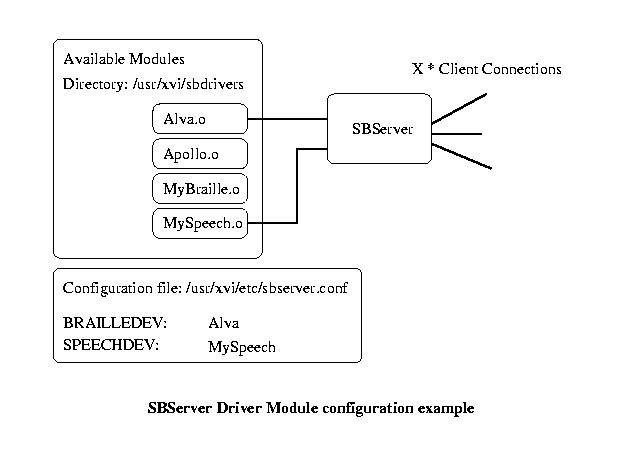|
|
XVI SystemsComputer access for the visually impaired and blind |
Any generic computer system with a screen, to usable by the visually impaired or blind must convey the information on the screen into a form understandable by these users. In today's technology the normal means of interface is either speech, braille or both.
Modern computer systems are complex and typically applications are developed
in a structured manner using where possible the tested and defined standard
work of others. The BEAM Speech/Braille server is intended to be such a
standard - Its objectives are twofold. Firstly to provide a framework upon
the suppliers of Braille and Speech can build a generic system. Secondly,
to formalise and implement a set of procedures that my be used by a application
wishing to output in speech and/or braille.
The speech system
Speech is used to convey information to the user. Typically the information on the display is logically partitioned allowing the user to traverse the display asking for, or provided with information at each step. For example when 'traversing' an application menu bar the words "file", "Edit" might be spoken and when "File" selected the words "pop up menu New" spoken.The purpose of this API is not to define the speech functionality but to allow an application the resources to generate and control this speech.
Braille displaysA braille display has a number of electrically driven cells, typically eight pins per cell which are used to display the 6 pin braille character set. The two additional pins are used for additional information such as cursor position. In addition a braille display may have a number of keys/buttons that may be used to aid or control screen reading. For example, a button might move down a line, to the next character, screen object etc.
The BEAM XVI screen reader for example configured, for use with an Alva 440 Braille display uses the front panel rubber front keys or what we refer to as object/text traversal, simplified, an object is in essence a screen entity such as a button, text entry cell, menu entry etc.The twin button rows above the status cells (left-most three cells) are used as mouse buttons and to scroll the line of text displayed on the remaining 40 cell.
The Speech Braille Server ArchitectureA generic interface for speech and/or braille devices. Support for simultaneous 'braille and/or speech' enabled applications and specific screen reader software. Simple addition of new speech/braille devices. The server will dynamically load the modules required. Third party and user modules can be easily developed. Fully networked remote access to braille/speech devices. Speech system supports output stream trigger points. Server automatically supports US and DK braille. Application history support to allow streamed logs such as kernel messages to be accessed.
BEAM have adopted a client/server style architecture to implement speech/braille access. This approach allows both generic screen reader software and 'braille/speech enabled' application to co-exist on the same computer. By 'braille/speech enabled' we mean applications such as emacs the various 'console' readers available - that directly support speech output. Generic screen reader software would typically allow the reading of applications that don't support braille/speech directly.
A server demon process 'sits' awaiting connection from one or a number of clients that wish to use the braille/speech device. Connection is made via TCP/IP sockets. It is not necessary for the client and server to run on the same host machine. Applications make use of the server by the functions provided by a small interface library.
From the perspective of a client a braille device has the following characteristics :-
The speach/braille device access library, linked with an application facilitates connection to, and use of an speach/braille device server.
The speach/braille device API is available in both 'C++' and 'C' forms.
The 'C' implementation comprises a set of 'C' functions that, when
linked with a application allow the
to output in speech and braille. Additional functionality allows an
application to perform actions at pre-determined points in the
speech output flow.
SBClient 'C' API
SBClient 'C++' API
The speech/braille server essentially provides an interface between
a client and a braille and/or braille display.
Imperative in the architectural specification was the requirement that
:-
The server program has been developed with the ability to dynamically load object files. When the server first starts up, it reads a text configuration file /usr/xvi/etc/sbserver.conf. This simple <TAG>: <data> format file contains the two tags SPEECHDEV: and BRAILLEDEV: the values read indicate the name of the object file to load.

The Main key group defines the main braille keys for screen reader navigation.
These are possibly at the front of the braille display. The key number
within this group is defined by the enum Key.
The Buts1 group is a line of buttons above the main text display cells.
The key number defines the braille cell position that the key is above.
The Buts2 group is a second line of buttons above the main text display
cells, if present. The Status1 group is a line of buttons above or connected
with the status cells, if present. The Status2 group is a second line of
buttons above or connected with the status cells, if present.
The key modifier bit field variable allows a simple key modifier action
to be performed. Currently the value returned can be 0 or 1. 0 is the normal
state and 1 is the modified state. Normally one the Main braille display
keys is defined as a shift key. If pressed in conjunction with another
key then the client will receive the latter key with the modifier bit set.
On the Alva Delphi we set the modifier to be 1 when the PROG key is pressed
in conjunction with any other key. If the PROG key is pressed on its own
then the user will receive just the PROG key.